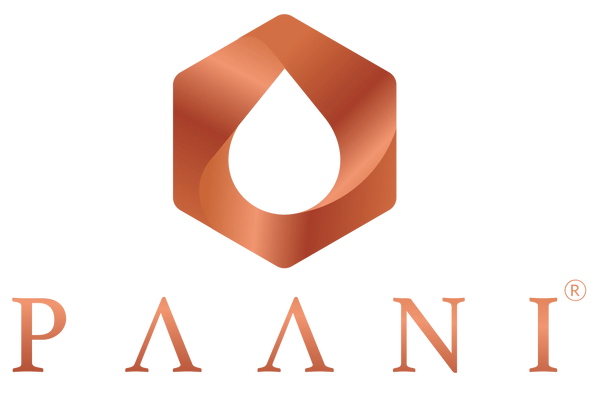COPPER CUPS EXPLAINED (2025): HISTORY, SCIENCE, BENEFITS & CARE TIPS
In recent years, copper cups and bottles have re-emerged from ancient wellness traditions into modern hydration rituals. But what’s the real deal behind this trend? In this guide, you’ll learn the history, science, benefits, and best practices for using copper cups, especially when they’re crafted with care, like those from Paani.
1) A Brief History: From Ancient Vessels to Modern Rituals
Copper vessels have been used for millennia in many cultures. In Ayurvedic traditions, storing water in copper overnight (known as Tamra Jal) was a daily practice in Indian households. Copper was believed to purify water and balance the body’s doshas. Over time, this ritual lost favour in industrial-era living but is now being rediscovered in the wellness world.
Modern brands like Paani are reviving that wisdom with modern design, testing, and teachings built for today’s lifestyles.
2) Why Copper? The Science Behind the Metal
Copper is naturally antimicrobial: when microbes land on its surface, copper ions can disrupt their cell membranes, helping to deactivate bacteria. That’s not just theoretical, copper's germ-killing properties are well documented in scientific literature.
What sets Paani apart: the copper we use is high-grade and lab-tested, from pure copper circles, and proven to eliminate bacteria such as E. coli and Klebsiella pneumoniae in lab tests. This gives confidence that each cup is made from copper that’s not just aesthetically appealing but functionally active.
3) What Makes a Quality Copper Cup?
Not all copper cups are created equal. Here’s what to look for:
- Purity: 99.9%+ copper, minimal alloys
- Handcrafted: artisan-made rather than mass-stamped
- Interior uncoated: so copper can freely interact with water
- Exterior protection: a thin, food-safe lacquer or protective layer to slow tarnishing
- Durable design: balanced walls, smooth edges, and good cup ergonomics
- Testing & certification: third-party lab validation for antimicrobial performance
Paani copper cups meet all these benchmarks, combining heritage craftsmanship with modern quality assurance.
4) Benefits of Drinking from Copper Cups
Using copper cups offers several advantages:
- Microbial safety: As mentioned, copper can reduce harmful bacteria.
- Mineral trace: Small, safe trace amounts of copper may leach into water, complementing dietary copper intake.
- Taste & freshness: Many users report a fresher, more crisp taste when copper is used to store and sip water.
- Ritual & slowing down: Drinking from a copper cup encourages mindfulness, a physical reminder to drink with intent.
- Sustainability: Reusable copper cups offset plastic use and reduce waste over time.
5) How to Use Copper Cups in Your Routine
Store water first: Fill your Paani copper water bottle and allow water to rest for 4–8 hours.
- Pour into cup: Use the cup to sip during meals or throughout the day.
- Avoid extremes: Don’t pour hot drinks, acidic beverages, coffee, or tea, these can react with copper.
- Daily rinse: Rinse your cup with warm water after use to minimize residue.
6) Cleaning & Maintenance Tips
- Weekly refresh: Use a mixture of warm water + sea salt + half a lemon (or a dash of white vinegar). Gently swirl, rinse thoroughly, and dry with a soft cloth.
- Avoid abrasives: No steel wool or harsh scrubs — they can damage the finish or interior.
- Store dry: After cleaning, leave the cup upside down to let moisture evaporate.
- Embrace the patina: Over time, copper develops a natural patina, this is normal and safe. If desired, you can lightly polish the interior using the lemon-salt method.
7) Common Myths & Misconceptions
Myth |
Reality |
| Copper cups purify chemical pollutants | No, copper combats microbes, but it doesn’t filter out pharmaceuticals or heavy metals. |
| If it never tarnishes, it’s better | Actually, no. If a “copper” cup never changes, it may be coated or less pure. |
| Copper is dangerous | When used properly (water only, occasional cleaning), a copper cup is very safe as it’s a mineral that our body requires. |
| It takes too much effort | The care practices are gentle and minimal, comparable to good cookware and many users find them meditative. |
8) Pair Sets: Why PAANI Sells in Twos
Paani handcrafted copper cups come in sets of two for a few heartfelt reasons:
- Ritual & sharing: Many wellness practices are best when experienced with another a partner, family member, or friend.
- Symmetry & harmony: Two items create balance in how we present and use them.
- Functional flexibility: If one is in use or being cleaned, you have the other ready to go.
Frequently Asked Questions
Q1: Can I drink juice or hot drinks in a copper cup?
A: We strongly recommend sticking to plain water only. Acids, hot liquids, or sugary drinks can react with copper and degrade the surface.
Q2: How long should water rest in the cup before drinking?
A: For best effect, pour water that’s been resting 4–8 hours in your copper bottle. The cup itself is for sipping; you don’t need prolonged contact in the cup.
Q3: Is patina safe or problematic?
A: Patina is a natural oxidation, not harmful. It shows your copper is authentic. If you prefer a bright interior, gently clean with lemon and salt.
Q4: Do copper cups really kill bacteria?
A: Copper’s antimicrobial properties are well documented, and PAANI’s copper is lab-tested to eliminate E. coli and Klebsiella pneumoniae, so yes, when used properly.
Q5: How often should I clean my copper cup?
A: Rinse daily with warm water when used. Once a week, use a gentle scrub with salt + lemon to refresh the surface if used daily.
